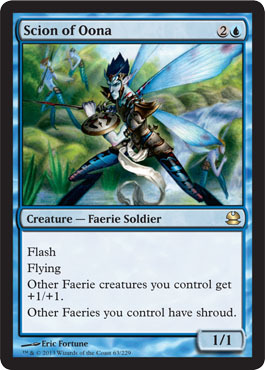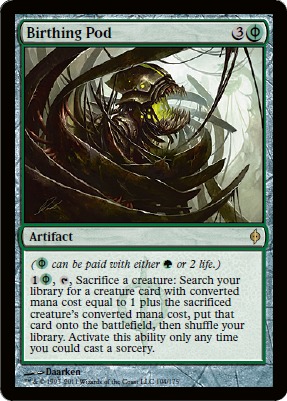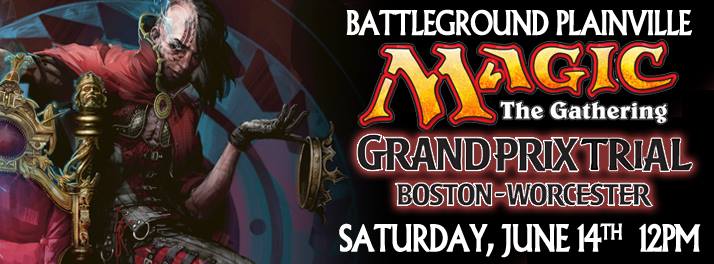Posts Tagged ‘UB Faeries’
Faeries in Modern & A Grand Prix Richmond Report by Dylan Klett
Friday, June 13th, 2014
Hello everyone!
Today I want to talk about the deck I brought along to Grand Prix Richmond to battle with. I have a lot to say about the deck and I’ll try to answer why UB Faeries was a good choice for the tournament, as well as whether or not it will continue to be one going forward.
For anyone who wasn’t able to make it, Richmond was truly a colossus of an event; the main hall housed some 3,000 people, from vendors to a VIP area to a sweet feature match ring complete with spectator stands. Even with all of that space however, the other 1,400 players (myself included) that attended the main event were almost literally stacked on top of each other, as we were relegated to the very swanky ballroom on the floor above to compete for Modern Mastery, in a tournament the likes of which had not been seen since one historic weekend in Vegas with a final attendance of 4,500 competitors.
My weapon of choice for battling such a vast field was a bit unorthodox, given the conventional wisdom that Bitterblossom seemed to have wilted on the vine during its time on the format’s banned list. However, after a great deal of testing, theory-talk about the format’s predicted direction, I decided to bet that Splinter Twin, Storm, UWR and the like would keep Wild Nacatl in the jungles of Naya, far away from Richmond, and I sleeved up Faeries:
Mainboard:
23 non-creature spells:
4x Bitterblossom
3x Thoughtseize
3x Inquisition of Kozilek
3x Cryptic Command
2x Dismember
2x Mana Leak
2x Spell Pierce
2x Sword of Feast and Famine
1x Go for the Throat
1x Smother
13 Creatures:
4x Spellstutter Sprite
4x Vendillion Clique
2x Snapcaster Mage
3x Mistbind Clique
24 Lands
4x Mutavault
4x River of Tears
4x Darkslick Shores
4x Watery Grave
3x Secluded Glen
2x Creeping Tar Pit
2x Island
1x Ghost Quarter
Sideboard:
2x Hurkyl’s Recall
2x Grafdigger’s Cage
2x Relic of Progenitus
2x Spellskite
2x Threads of Disloyalty
2x Engineered Explosives
1x Annul
1x Damnation
1x Glen Elandra Archmage
For the unfamiliar, Faeries is a deck that plays similarly to the UW Delver of Secrets decks of past Standard, in that it tries to establish a reasonable amount of pressure on the opponent, while at the same time preventing them from utilizing the most powerful parts of their deck’s plan. Rather than an entirely offense-oriented deck like Zoo, or an entirely defense-oriented deck like UWR Control, Faeries plays like a hybrid of the two strategies, utilizing the elements of both while committing entirely to neither. With that said, let’s talk a bit about the specific card choices, and how they work together to form a flexible game plan.
Bitterblossom

Bitterblossom is the answer to this problem. Once you’ve invested a mere 1B into it, Bitterblossom will provide you with all of the pressure you need to kill your opponent without ever tapping out again. When you consider that it does this while simultaneously powering up your Spellstutter Sprites and Mistbind Cliques, blanking opposing large creatures like Tarmogoyf by chump blocking almost indefinitely, is essentially immune to both premier removal spells of the format (Lightning Bolt and Path to Exile) and more, it becomes easy to see why Bitterblossom is the beating heart of what makes Faeries competitive. If you’re going to play this deck, play four.
Spellstutter Sprite

Vendillion Clique

Mistbind Clique

The Spells
When people think of Faeries, they think of Bitterblossom. While the card is without a doubt absolutely vital to the deck’s existence, making sure your build contains the correct selection and number of spells for the metagame you expect to face is just as important as making sure you have four Bitterblossoms in your main deck.
Much more so than the creature base, this selection of cards is more flexible. I personally prefer a smaller number of removal spells and a larger number of counter and discard spells; other builds play a larger amount of removal, but I feel as if the cards that you are most often forced to react to, the ones that distract you from killing your opponent, are better answered by discard and counterspells rather than removal. Part of playing Faeries is becoming adept at determining which cards your opponents plays that you can afford to ignore. You aren’t playing enough removal or counters to counter everything, so you have to kill them before they overwhelm the amount of disruption you can put up. You can often disregard or kill one or even two Tarmogoyfs, but things like Cranial Plating, Blood Moon, Birthing Pod, Chord of Calling, and more are all cards that Faeries cannot allow to impact the game. Because of this, cheap counters and removal like Spell Pierce and Dismember play an important role, because you are able to cast more of them with your limited amount of mana than you would if they were more generically powerful, expensive spells like Deprive or Go for the Throat.
Cryptic Command is the notable exception to this rule. While the other spells that make up the deck are mostly situational, requiring the right set of circumstances for maximum effect, Cryptic Command is the one card that will always be good for you. While the mana is too constrained to play the full four, the difference between drawing one in the late game is often enough to cement an otherwise uncertain victory, or swing an otherwise unfavorable game back into your court.
The Lands
One of the big draws to UB Faeries is that your manabase is almost entirely painless. Bitterblossom and Thoughtseize hurt, but they give you a larger degree of control over your own life total–especially in the early turns–than a fetchland/shockland mana base would. The manlands are also crucial; while four Creeping Tar Pits is too many with all of the early discard and countermagic, don’t even think about sleeving this deck up with fewer than four Mutavault. Mistbind Clique and Spellstutter Sprite can’t exist without the presence of this card in the deck, and as we continue to see in Standard, the presence of an early mana source that provides a late game blocker or attacker is invaluable. As a last note, I don’t think the one-of Ghost Quarter is necessarily correct. There are some matchups where it’s excellent to see (Affinity, Pod, even Jund to an extent, occasionally Tron), but I think the problems Ghost Quarter can address are better dealt with through the sideboard rather than slightly straining the mana base. It’s important to get to four lands to cast Cryptic Command and Mistbind Clique, and being forced into a spot where you want to use Ghost Quarter but can’t afford to because you need the mana is miserable. I think this should be switched to the third Creeping Tar Pit.
Scion of Oona (or the lack thereof)

Scion of Oona is a card with very defined uses; it provides a faster clock when you have a collection of smaller faeries, and it protects against spot removal. Faeries is already a deck that is inherently strong against spot removal like Lightning Bolt or Path to Exile, making the shroud ability of the card less powerful than it might be in a vacuum, and downright distasteful when you consider how clunky (and occasionally blank) it makes Sword of Feast and Famine. The only useful part of the card comes when you can protect a Bitterblossom from Abrupt Decay, but this is far from convincing enough of an argument to sacrifice already precious slots for the card.
It’s important to address the place that Faeries occupies in the metagame.
The Pro Tour before Richmond was enormously combo-heavy, with Zoo getting pushed out by both hate and simply lack of performance. Storm was one of the best-performing archetypes overall, and the rest of the Top 8 was filled with minimally interactive combo decks, Birthing Pod, and Snapcaster/Path/Bolt decks with Colonnade. Because of this, I didn’t plan on twisting my decklist to beat Zoo; it’s not worth it, nor does it seem particularly relevant.
Normally, with a wide-open, unknown format, aggro decks are king for the first few tournaments, while the control decks catch up eventually once they know what targets they have to aim for. I think combo took that role from Aggro this time, as they seem to be simply more powerful/faster versions of the same goal; kill your opponent as quickly as possible, goldfish-style. No one knew what to expect, so control had to aim broadly (see: McClaren’s list) and try to react to a little bit of everything. Faeries has enormous game against unfair decks; how much of that list is dedicated to discard and countermagic again? Living End is as close as it gets to a bye without actually losing to variance, Bitterblossom is brutal against UWR, and you pack higher levels of disruption and pressure than Twin does, letting you force them into playing a tempo game instead of their risky, fragile combo- and you’re FAR more suited to play a tempo game than they are. Zoo isn’t even brutal post board; it’s not a good matchup, but it’s winnable, assuming fighty cat isn’t too ashamed of its game against unfair decks to show up in force.
An important part of playing a Faeries deck competently and competitively is being very aware of the important cards and interactions in certain decks and strategies, so for the last part of this article I want to address a few key points about how Faeries plays against the known Tier 1 decks in Modern, as well as a few others.
Affinity
Affinity is an aggro deck at heart, and a very good one. No other deck has nearly the number of backbreaking sideboard cards geared against it than Affinity does; Stony Silence, Hurkyl’s Recall, Creeping Corrosion, Ancient Grudge, Shatterstorm, Kataki, War’s Wage and more are all cards capable of single-handedly demolishing the Affinity strategy. Given that all of this hate exists, it’s a testament to the deck’s power that it continues to put up outstanding results, with at least one copy in almost every significant Modern event’s top 8.
I believe that Faeries has a very winnable, and possibly even favorable match up, and this is because of the way Affinity functions as a synergy deck. In essence, affinity is a pile of mostly garbage cards that happen to be artifacts (Memnite, Ornithopter, Vault Skirge, etc.) coupled with about 16-18 outstanding synergy engines that all perform a powerful function in slightly different ways. This plays right into Faeries hands: the whole point of the deck is to disrupt key components of the opponents strategy long enough to kill them before they can come fully online. Unlike a deck like Birthing Pod, where countering their signature card still leaves the deck full of cards like Kitchen Finks, Murderous Redcaps, and other reasonable standalone creatures, countering all of the key cards in Affinity leaves them trying to beat you to death with small 1/1 creatures. The deck with Bitterblossom is quite favored when it comes to this sort of fight. After sideboard, you get access to the devastating Hurkyl’s Recall as well as Engineered Explosives, while getting rid of Thoughtseize.
As a last note, you need to respect the synergy engines of Affinity in a specific order that may not be immediately apparent: while most other decks are given the most trouble by Cranial Plating or Etched Champion, Faeries is one of the few decks most vulnerable to Steel Overseer. Again, you want to be able to ignore most of Affinity’s cards and counter or kill the ones that matter; Steel Overseer (and to an extent, Master of Etherium) makes all of Affinity’s cards matter, so letting them untap with the card is a sure way to have your resources overloaded.
Splinter Twin (and variants)

It’s worth taking note of the popular Tarmo-Twin variants, where they essentially push their mana base harder in exchange for access to a wider sideboard and access to some creatures that actually demand attention, as opposed to simply their combo pieces, Snapcaster Mage, and occasionally Vendillion Clique. While Tarmogoyf is as always a creature you need to respect, the addition of it to Twin’s game plan just makes it so that you can’t race their life total completely unimpeded, and that you do have to manage some of your resources with it and Scavenging Ooze (who performs an almost identical role in this matchup) in mind. Jund is still the better Tarmogoyf deck against you, so as long as you present a reasonable clock and don’t let them establish too heavy of a board presence that you need to go entirely on defense, this is still a very difficult matchup for Twin to win.
UWR Control
Another great match up for Faeries. Unlike Twin, they can sometimes kill you through resolving a troublesome permanent like Elspeth, Knight-Errant or Gideon Jura, but for the most part their deck relies on spot removal and Snapcaster Mage to clean up opposing threats, and win a longer attrition game. As we’ve already established, Faeries is a deck that cares little for spot removal; the best it’s going to get against us (unless we get sloppy with Mistbind Clique) is to kill our Vendillion Clique, which is already a value-positive trade for us. Ajani Vengeant, the Planeswalker they tend to rely most heavily on, is poor against us for the same reason their spells are; single-target effects are just not good enough against the Faeries game plan. Discard and Bitterblossom are outstanding in this match up, and this is one of the match ups where Faeries’ ability to play almost entirely at instant speed really shines. Pay attention to your life total to avoid unfortunate encounters with large numbers of 3-damage burn spells, and enjoy the look on their face every time they’re forced to Bolt or Path to Exile a Bitterblossom token.
Birthing Pod

This is not to say this is an unwinnable or even heavily unfavorable match up; but for the same reasons that Faeries is favored against Splinter Twin and UWR, Pod is favored against Faeries. As anyone who has played even a little Modern has already found out, an active Birthing Pod is a difficult card to beat, and Faeries is particularly hurt by the inability to profitably interact with the card outside of counter spelling the card directly. Kitchen Finks is a creature that comes down early and is difficult to race, and most brutally, most Birthing Pod variants have begun to main deck at least 2, if not 3, Voice of Resurgence. This card in particular fundamentally cripples the way Faeries operates, and we are often forced to trade off large amounts of resources and tempo just to turn it into a larger creature than it was before! This card combined with the already inherently advantaged game plan of Birthing Pod makes it so that Faeries has a hard time putting up a consistently positive record against it.
After sideboard Grafdigger’s Cage helps enormously, and I’ve been experimenting with additional tools like Batterskull and Hibernation (which seems particularly good against Voice of Resurgence), so it’s possible I simply haven’t found the best strategy against the deck yet. As a general sideboard plan, this seem to be the only match up so far where Spellstutter Sprite is better left out after game one. Spellstutter is often best at countering 1 and 2 drops during the early game where it’s most important for Faeries to interact favorably, and the inability of the card to catch either a turn one mana dork like Birds of Paradise or Noble Hierarch, or the card that it most often ramps out—either Kitchen Finks or Birthing Pod—makes it so that the card is only useful in the later game as a counter spell, which is the point in the game after Pod has already established a generally superior board presence.
Discard is too important to snag either a Birthing Pod, Chord of Calling, or Voice of Resurgence to board out, so its more important in this match up than most to consistently apply pressure, because without forcing the Birthing Pod deck into an uncomfortable situation, they have inevitability, particularly in games where you don’t draw Grafdigger’s Cage or Sword of Feast and Famine, both of which are vulnerable to Harmonic Sliver, Abrupt Decay, and Qasali Pridemage. If anyone has concrete suggestions on how to improve the match up, I’d love to hear them!
That’s it for today, I hope you guys enjoyed reading about my favorite deck in Modern. I think Faeries will continue to be a powerful choice as long as Wild Nacatl is kept out of the top tables by more powerful and flexible decks, which will make Bitterblossom an excellent tool for preying on more intricate, spell-based strategies.
Until next time,
DZK
About Battleground Games & Hobbies
| |||||
| |||||
Tags: Grand Prix Richmond 2014, Magic the Gathering, Modern, MTG, Tournament Report, UB Faeries
Posted in Blog, Card Games, Events, Featured Author, Featured Post, Magic: The Gathering, Store Related | 2 Comments »
- Products
- Buylist
- Policies
- Contact Us








Social: